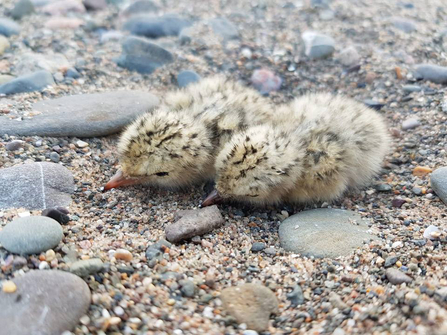
Two of the four little tern chicks which successfully fledged at South Walney Nature Reserve in 2018

Two of the four little tern chicks which successfully fledged at South Walney Nature Reserve in 2018
We are delighted at the successful fledging of this diminutive seabird on our nature reserve near Barrow this summer. Sarah Dalrymple, Warden at South Walney explains: “Little terns have been breeding intermittently on the nature reserve since the mid-1980s. However they’ve had little success in actually rearing the chicks, and most years they haven’t bred here at all. The last time that chicks fledged was in 1985, so it’s great to see four chicks have flown the nest this year.”
Little terns are very vulnerable to disturbance, which is why there are only 1,200 pairs left in the UK, four of which are at South Walney Nature Reserve. Sarah explains how damaging human activity can be to these seabirds: “Repeated disturbance causes the birds to abandon their eggs and young, which is very sad. Due to their rarity, little terns have extra protection in law, and disturbing them when they are at their nest is a criminal offence, under the Wildlife & Countryside Act (1981). Motor vehicles, including quad bikes and dirt bikes, are not allowed on the foreshore of the nature reserve or above mean high water (the boundary of the nature reserve) without the landowner’s permission (an offence under the Road Traffic Act).”
Cumbria Wildlife Trust works hard to protect wildlife and habitats on nature reserves such as South Walney and nearby at Foulney Island, where there are 40 pairs of little terns. Unfortunately, members of the public don’t always follow the warning signs and trespassers do occasionally drive on to the reserves. Quad bike tyre tracks were recently seen on South Walney, very close to one of the tern nests. Earlier this year the driver of a Land Rover got stuck when he drove illegally on to the sands off South Walney, damaging the vegetated shingle beaches.
Living up to its name, the little tern is the UK's smallest tern and can be seen nesting on gravelly beaches in small colonies. It feeds just offshore, hovering above the water before diving in to catch its prey of small fish. A summer visitor to Europe, the little tern leaves in August to spend the winter in Africa. Silvery-grey above and white below, the little tern has a black cap, a black eyestripe, and a white forehead. It has a short tail, tiny, yellowy-orange legs, and yellow bill with a black tip.
Little terns - Dorest Wildlife Trust (https://youtu.be/NcmzbImd-aM)
Little Tern Project - Chesil Beach. A project managed by the RSPB with support from Dorset Wildlife Trust, Natural England, The Portland Court Leet, the Crown Estate & the Chesil Bank and Fleet Nature Reserve.
Watch a short clip of a Little tern and its chicks.